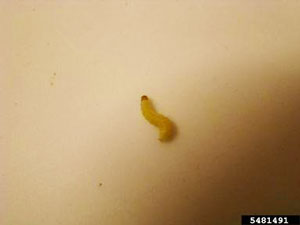Food Moths Can Be Traced to a Rodent Infestation
By Chris Williams on November 19, 2014.
We’ve had an ongoing problem in a bedroom with what we’re told are Indian meal moths. I thought these moths fed on people foods and were found in a kitchen. We never see them in the kitchen but have found dozens on the walls of the bedroom. Any idea where they’re coming from? A. W., Stratham, NH
 You’re right that Indian meal moths are one of the stored food product pests. They feed on a wide variety of foods ranging from flour and cereal to chocolate and spices. The larvae develop in the food product, often crawling away to spin a pupal cocoon. The adult moth that emerges from the cocoon hides in dark places during the day and becomes active at night, flying in a zig-zag manner.
You’re right that Indian meal moths are one of the stored food product pests. They feed on a wide variety of foods ranging from flour and cereal to chocolate and spices. The larvae develop in the food product, often crawling away to spin a pupal cocoon. The adult moth that emerges from the cocoon hides in dark places during the day and becomes active at night, flying in a zig-zag manner.
Indian meal moth adults will fly some distance from their food source since they are attracted to light. Even when breeding in a kitchen, they can be occasionally found in other rooms, but not usually in the numbers you mention.
Food Sources Outside of the Kitchen
Because Indian meal moths feed on such a range of things, they sometimes infest items that you would not at first consider to be foods such as bean bag toys, fish or turtle food, horsehair furniture stuffing, jewelry or pictures made of seeds or beans, and many more (see Pantry Pests Outside of the Pantry).
Perhaps the most common source of Indian meal moths found away from the kitchen is food that has been hoarded by rodents in wall or ceiling voids, or in attics. Rats, mice, and squirrels collect dry pet food, bird seed, or any kind of food that is available and hide it away in hidden sites, presumably to eat later (see Do Mice Eat Dry Pet Food?). These food caches are usually in or near the kitchen, but not always. If dry pet food is left out in a different part of the house, the hoard may be inside a wall in that area instead (or even directly above or below the kitchen).
Some stored food pests will find and infest rodent-hoarded food right away (sometimes it’s already infested when the rodents hide it). Other food pests move in when the food gets old or moldy. A rodent food hoard can accumulate over many months and can result in hundreds of insects finding their way out of the hoard and into living space.
Control the Mice to Control the Moths
You need an inspection from a professional exterminating company that understands that Indian meal moths may not be your only problem. If the source of the moths is food hidden away by rodents, you need rodent control as well as moth control for a permanent resolution. Once the food cache is located, it must be removed and the site treated for moths. A trapping or baiting program will eliminate the offending rodents. Your job then is to do better at managing pet food or whatever food the mice are stealing (you’ll know the answer to that once you locate the hoard).
Photo: Ryan Jones, Colonial Williamsburg Foundation, Bugwood.org
Sign up for our biweekly email newsletter for more information about bugs and pests!